
Sense's Reminiscences
by Sense de Jong
- Geurt
- Tante Betje (by Sense)
- Tante Betje (by Truus)
- Miss Roozendaal
- Concert in Winschoten
- A baptism remembered
- My birdhouse
- War veterans
- Henk Smit - bass/baritone
- Stefan
- In memory of Herman - I
- In memory of Herman -II
- Remembering AK
- Our love for music
- Herman - Promoter of Christian Causes
- A Salem evening with Herman de Jong
- From Elsinore to Monschau
- A Danish Treat
- Glimpses of Thuringia and Saxony
- Domie and Hansie
- La Manche, Newfoundland
- Bermuda - Isle in the Sun
- 1932 and 1934
- 1940 - 1945
- Winschoten, Grace on the Venne
- 1948
- Johann Sebastian Bach
- From Generation to Generation
- Seven children and a harmonium
- K.P. - A Man of Enterprise
- Cuba and the tragedy of the MS St Louis
- It all began in Norwich, Ontario
Another site by Sense de Jong:
~ Hinne de Jong ~
A Chronicle
Sites by Henry de Jong:
~ Herman de Jong ~
Memorial
~ Newmaker Notes~
Writings, Pictures, Collections
~ AACS/ICS Niagara Conferences~
1970 - 1991
In 2009, Corrie and I became acquainted with two books which moved us deeply. Both stories were written shortly after the end of Word War II and describe the terrible oppression and deportation of the Dutch Jews and the efforts of the Dutch resistance groups to save them.
Both books are also testimonies of the power of God's grace and of His love in dark and dangerous times. How surprised we were to discover, after reading about the Rev. Ader's parsonage in the province of Groningen, to find another - but very much related - book focussing on how the Nazis attempted to cleanse the Netherlands of its Jewish citizens and refugees from other countries who had escaped to the Netherlands before the war.
Corrie and I were respectively four and six years old when the war started in May, 1940. Corrie grew up in the Frisian town of Surhuisterveen, and I was raised in the east-Groningen city of Winschoten.
There are three places that figure prominently in the two books mentioned above. The first is a parsonage in the Groningen village of Nieuw Beerta, close to the railroad tracks between Winschoten and Nieuweschans (on the German border). The second is the notorious Concentration Camp Westerbork - located no more than 50 kilometres from either Surhuisterveen or Winschoten - in the province of Drenthe. Finally, the Dutch capital city of Amsterdam, located in the central section of the Netherlands. From here, most Dutch Jews were deported by train, via Camp Westerbork, to Germany's death camps.
Tante Jo and Domie's place of refuge
The first book was written by Johanna Adriana Ader-Appels, widow of the Rev. Bastiaan Jan Ader, pastor of the "Hervormde Kerk" (Reformed Church) in Nieuw Beerta. Everyone just called her Tante (Aunt) Jo. Pastor Ader - unbeknownst to nearly all members in his congregation - was very active in the Dutch resistance movement and was known as "Domie" by the Dutch underground. (Note: "Domie" is the Groninger dialect version of the word "Dominee" or Pastor -sdj.)
Known to only a few people in the congregation, the Nieuw Beerta parsonage became a secret hiding place for many people Domie wanted to shield from the police and Gestapo (German Secret Police). Had this brave couple ever been found out, they would have been shot!
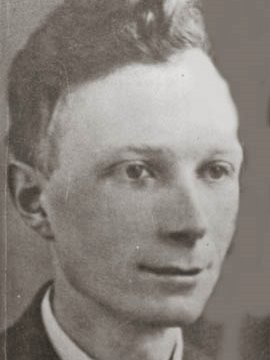

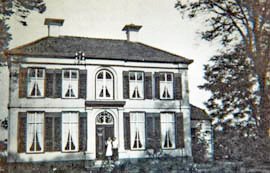
- WW II hiding place.
The building is no more today.
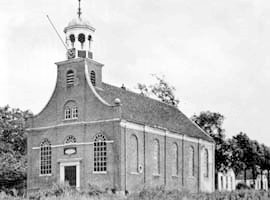
in Nieuw Beerta
During the war years, Domie travelled tirelessly (using mostly bike and train) all over the country working on behalf of hundreds of Jews and others whom he provided with addresses of hiding places. Sometimes, when he was home with his family, the alarm went off because the enemy was prowling around. The special guests disappeared and all traces of their presence were quickly erased. Domie vanished through the bushes into a small door leading into one of those huge, Groningen-style, barns next door. He was never found!
No doubt, he was regularly in touch with a whole network of other resistance leaders in the Netherlands. Many people got to know him. But one of them likely betrayed him in 1944 somewhere in Holland.
He was arrested and taken by the Germans to the infamous Gestapo prison on the Weteringschans in Amsterdam. The letters Domie wrote from that fearful prison to his wife reveal this man's deep faith and trust in his heavenly Father. They are precious, indeed!
In Amsterdam he suffered physical and mental abuse at the hands of the Gestapo. One day, however, he was suddenly taken from his cell and, together with other prisoners, was transported to an area close to Veenendaal (near Utrecht). There everyone was lined up and executed by the Germans....
The title of the book is "Een Groninger pastorie in de storm" or "A pastor's house in Groningen in the storm." Published in 1947 ( by T. Wever B.V - Franeker, the Netherlands), it was reprinted at least twelve times in Dutch. None of my research turned up any evidence that this book was ever translated. How unfortunate!
The story of Hansie
The author of the second book is Johanna-Ruth Dobschiner ("Hansie"), born in 1925 in Berlin from Dutch-Jewish parents. Because of the rise of Nazism, this strict orthodox Jewish family moved to Amsterdam during the late 1930s.
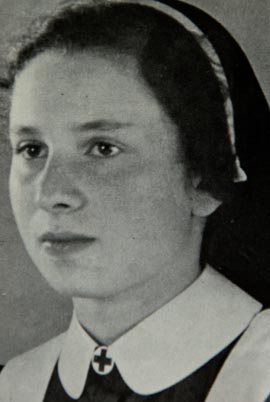
("Hansie")
During the early war years, Hansie and her parents lived close to "De Hollandsche Schouwburg" (the Theatre) located on the Plantage Middenlaan in Amsterdam. There they observed the beginnings of the terrible persecution of the Jews. As had happened years ago in Germany, people began to disappear mysteriously. Some of the Jews committed suicide. Rumours about transports to German death camps began to circulate. The Germans - often assisted by ordinary Dutch police! - began the system of registration of all Jews and started to round them up.
In 1941, the Gestapo began to systematically terrorize the male Jewish population in Amsterdam. They started grabbing all men and boys wearing a yellow star and took them to one of the squares in Amsterdam. One day, Hansie's dear brothers, Werner and Manfred, were among them. Werner, the weakest of the two, was taken to Buchenwald Concentration Camp (near Weimar) where he quickly succumbed to the mistreatments and grim conditions there. Apparently, Manfred was with large group taken to the dreaded Mauthausen Concentration Camp (between Munich and Vienna) and that is where he perished. Oh, how Hansie and her parents missed those boys....
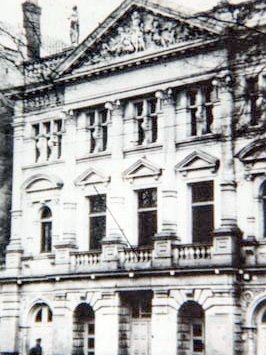
(the theatre)
in Amsterdam.
The lorries carrying the Jews were taken to "De Schouwburg" which had been confiscated by the Germans. Early in 1943, Hansie had found employment at the Creche (day nursery) which is located right across "De Schouwburg" on the Plantage Middenlaan. Prior to that, she worked as a nurse at the "Joodsche Invalide" (Jewish Hospital) located near Amsterdam's Weesperplein.
On April 9, 1943, German soldiers invaded her parental home and ordered everyone to get ready to come with them. Hansie was upstairs scared out of her wits. As the heavy boots came nearer and nearer up the stairs, Hansie remained behind as her parents were directed to a lorry on the street. Hansie's mother excused herself and asked for permission to check if the gas and electricity had been turned off. Permission was give! In so doing she came closer and closer to the place where she knew Hansie was hiding. Can you imagine what went through them when they fell into each other's arms? Mom embraced and kissed Hansie speaking words of encouragement. This would be the last time they would be together!
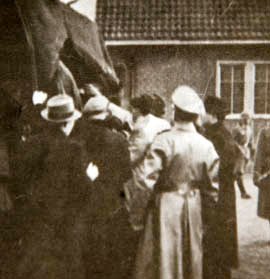
another lorry...
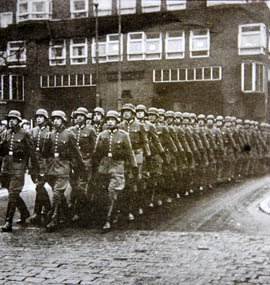
through Amsterdam
The lorry, fully loaded with another "harvest" of Jews, drove off and eventually everyone got off at "De Schouwburg," where they joined other captured Jews in this holding centre.
Hansie remained in her home the rest of that day and all of the following night. Quietly, she walked through the house for the last time. She packed a little suitcase and put on as many layers of clothing as possible. At 6 a.m. the next day she crept out of the door staying as quiet as a mouse. She knew Amsterdam like the back of her hand. Ten minutes later she arrived at the Plantage Middenlaan and approached the Creche across "De Schouwburg." She rang the bell and the assistant- matron opened the door and let Hansie in. The matron said: "You are early, my child, come in." Hansie found refuge there. She knew that right across the street her parents and many friends were in the clutches of the S.S., awaiting "re-location."
Later that day a dozen army lorries began to line up in front of "De Schouwburg." Slowly the people inside - mothers, fathers, children, grandparents - walked out of the building and were herded into those lorries. Hansie peeked from a window and watched in horror from across the street. And then, yes, ... there was her beloved, sad-looking mother and her ashen-facedfather. Did they suspect where Hansie was? Mother lifted her face momentarily towards the Creche....Hansie saw the lorries leave for the train station. Like her brothers Werner and Manfred, her parents did not survive the war.
Day after day, the lorries came and were filled with Amsterdam's Jewish population. The lorries drove, most likely, to the "Centraal Station" (main train station) or another smaller, closer-by station, called the Muiderpoortstation. There the Jews were ordered into freight cars that took them to Hooghalen, close to Camp Westerbork, in the province of Drenthe. This place was called a " Judendurchgangslager" (transit camp for Jews). Anne Frank and her family stayed here as well. Following a work period in that camp, the Jews were ordered into other trains that took them to death camps in Germany or beyond. Those trains regularly passed through my hometown of Winschoten, on the way to Nieuweschans and into Germany. I was too young to know what was happening! (Note: See also the two "Tante Betje" stories elsewhere on this website -sdj.)
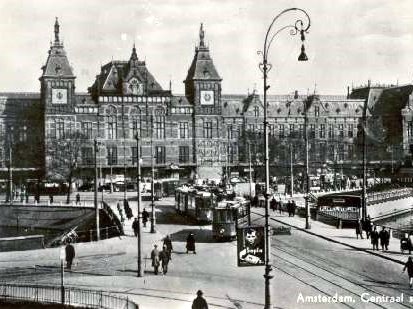
Centraal Station (main train station in Amsterdam) from where the trains departed to Westerbork.
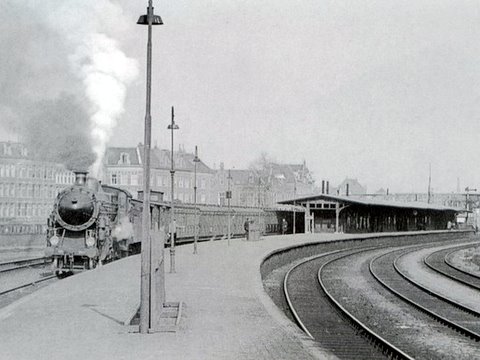
A train departing Amsterdam
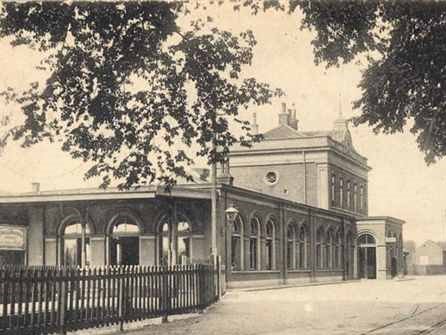
The trains from Westerbork to Germany came through this station in Winschoten, my home town.
Hansie remained in hiding in Amsterdam, but during the year 1943 the Gestapo stepped up the hunt for more Jews. It became increasingly dangerous for her, and others, to stay. But her plight became known to Domie, the pastor of the Reformed Church in Nieuw Beerta, Groningen.
On September 8, 1943, a non-Jewish concierge at the hospital told Hansie that she would need to go into hiding and that a certain man would come for her. And that's how she got to know Domie who took her from Amsterdam to the Nieuw Beerta parsonage which, as mentioned, became a haven for "onderduikers" (persons in hiding) almost to the end of the war. Hansie, in her book, called Domie "Daddy Long-Legs."
Hansie relates how Domie and she travelled the many kilometres to the northern part of the Netherlands, first by train, then by bike, somehow getting past all the police security checks. But that is a story by itself.
(Note: Corrie and I had the privilege to visit "De Hollandsche Schouwburg" on the Plantage Middenlaan in Amsterdam on several occasions. It is now a monument commemorating the Dutch Jews murdered during World War II. A brochure states: "In 1993, the theatre was renovated, redecorated and reopened. In the memorial hall 6,700 surnames pay tribute to the 104,000 Jews who were deported from the Netherlands and were killed in concentration and extermination camps. The educational exhibitions caters mainly to children and depicts the gradual isolation of the Jews during the Nazi occupation and their progression to the transit camp Westerbork." A visit to this site leaves no one unmoved. - sdj.)
Discovering Christ
What makes Hansie's story so remarkable is that - while hiding at the Nieuw Beerta parsonage with many others - her eyes were opened and she accepted the Lord Jesus as her personal Saviour and Lord. She had been going through Domie's library and found a copy of the Bible. She recognized the Old Testament, but she had never read the New Testament. She began to extensively study this, for her, new book (in Dutch). She was surprised that Christians knew so much about the Jewish history as described in the Old Testament. Under the tutelage of both Tante Jo and Domie, she discovered that the God of Abraham, Isaac and Jacob was the Father of Jesus Christ, the Messiah, the Redeemer of the world! In her own language: "Joshua Hamoschiach!"
Towards the end of the war - when the Gestapo furiously increased the number of raids throughout the country - Domie smuggled Hansie away from Groningen to the province of Limburg, in southern Holland. With her excellent command of the German language she slipped by German soldiers on the train and was finally met by "Oom Henk" (another leader in the resistance) who took her to a lonely, but safe farm. She went from one safe house to another. In late 1944 that part of Holland was liberated by the Allied Forces. The fighting and destruction was terrifying. But the central part of the Netherlands remained in German hands. So began the infamous hunger winter of 1944-45. But Hansie, after much suffering, was safe and free.
Hansie found refuge with the family Heemskerk and Mrs. Heemskerk became a "Moeke" (Mom) to her. With that family she attended the local church and then Hansie decided to explore how to become a member. She made an appointment with the pastor who urged her to come to "Catechisatie" (confirmation classes). She told him that she had read the New Testament over and over again and said she was almost sure she knew all Christ required of her. Some time later, on a Friday night, she met a group of elderly gentlemen, in black suits and black ties, sitting stiffly around a table. The men soon relaxed after hearing Hansie's responses to the pastor's questions.
That following Sunday, the family Heemskerk took Hansie to church and that morning she came forward to confess Jesus as her Lord and Master, following which she was baptized in the name of the Father, Son and Holy Spirit. Hansie, the Jewess, was now a member of the Christian Church!
Back to Amsterdam
In 1945, Hansie returned to Amsterdam. What an eerie feeling it must have been to visit the square from where Werner and Manfred were taken never to be seen again. To walk the street where the Dobschiners once lived. Other people now lived in the house there. She visited some old friends who were overjoyed to see Hansie again. But it was not the same. Her old haunts in the city were so different....
She also met some of the people she had worked with at the Jewish Hospital. To those people she was still Jewish, embracing the Jewish beliefs. But Hansie soon told them the truth that she had been baptized and had become a follower of Jesus Christ. When explaining all this, she detected a trace of irritation in some faces. Hansie quotes a senior person as saying: "What on earth are you saying? Have you started studying theology or something? You almost sound like Geschmad (i.e. an Apostate, a Jewish person baptized into the Christian faith).
To Hansie this accusation must have really stung. But she patiently and courageously explained that she had read the New Testament, but not before she had thoroughly traced her way through the Tenach (the O.T.). Through the power of the Holy Spirit her eyes were opened! She wrote: "It was then I learned a lot that I had never heard at Cheder (Jewish School) regarding the birth, life and death of one of our own prophets called Jesus of Nazareth." But she could not convince her hearers and knew she had to leave sooner or later.
In 1947, Hansie moved to Scotland, settling in Glasgow. She married and the couple had two children. Initially, it was not her intention to publish her story. She wrote it mainly for her children. Urged by friends, she published her memoirs in English and this version has since been translated into Dutch, German, Finnish, French, Norwegian, Portuguese, Spanish and Swedish. The English title is "Selected to Live!" and was published by Fleming H. Revell Company, Old Tappan, New Jersey, U.S.A - ISBN 0-8007-0613-7. (Note: The title of the Dutch translation is "Te Mogen Leven!" It was published by T. Wever B.V. - Franeker, the Netherlands.)
Let's thank the Lord that now so many people have access to these wonderful stories!
* * * * * * * *
Postscript
During the year 2005, Corrie and I visited the area of the former Camp Westerbork, lying in a beautiful, wooded area of the Dutch province of Drenthe. The main building is called the "Commemorative Centrum Camp Westerbork." We wandered through here to get a sense of what this horrible place was like but mostly to honor and remember the dead. If you've seen pictures of a Nazi concentration camp, this was much like it.
During 1971 the last barracks were demolished and most of the barbed wire and guard towers, etc. disappeared. We wandered through this large, grassy area. Here and there one sees an indentation in the grass...a sign of another building. In a corner we came upon a sign which said that this was where the punishment hut stood where Anne Frank was held.
We were astounded to see the large number of red stones (appr.102,000!) in the grass which were laid in the pattern of the map of The Netherlands, each province showing the number from that area who perished in Germany. The stones are of different heights...representing a mother, a father, an "opa," an "oma," an uncle, an aunt, a brother, a sister, a son, a daughter, a cousin, a friend, a neighbour, a classmate. By far the most stones were shown in the area of Amsterdam on the map. My hometown, Winschoten, was represented among those shown in the Province of Groningen. Almost 400 Jews lived in Winschoten before the war. Except for a handful, all of them perished.
Here is a quote from Wikipedia:
"Between July 1942 and September 1944, almost every Tuesday a cargo train left for the concentration camps Auschwitz-Birkenau, Sobibor, Bergen Belsen or Theresienstadt. In the period from 1942 to 1945, a total of 107,000 people passed through the camp on a total of 93 trains. Only 5,200 of them survived, most of them in Theresienstadt or Bergen Belsen, or were liberated at Westerbork" (by the Canadian Second Infantry Division-sdj).
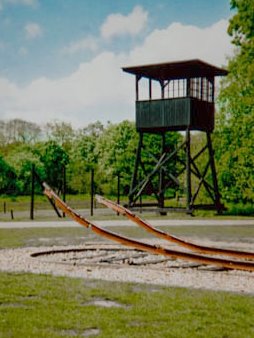
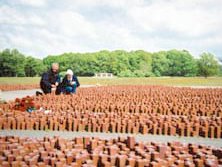
among the thousands of stones
at Camp Westerbork.
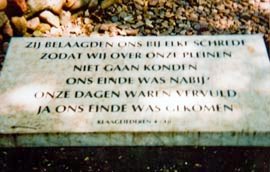
so we could not walk in our streets.
Our end was near, our days were numbered,
for our end had come."
[an error occurred while processing this directive]